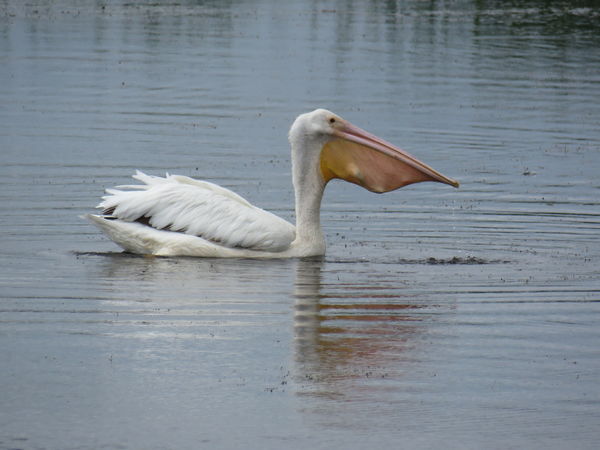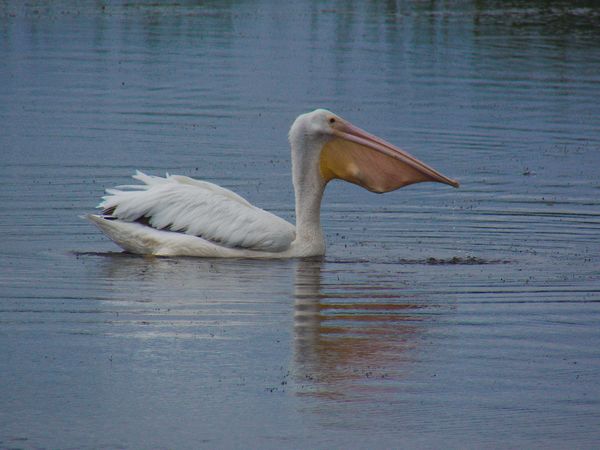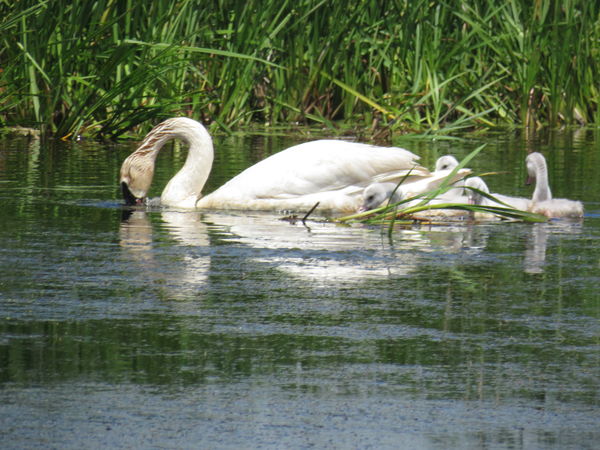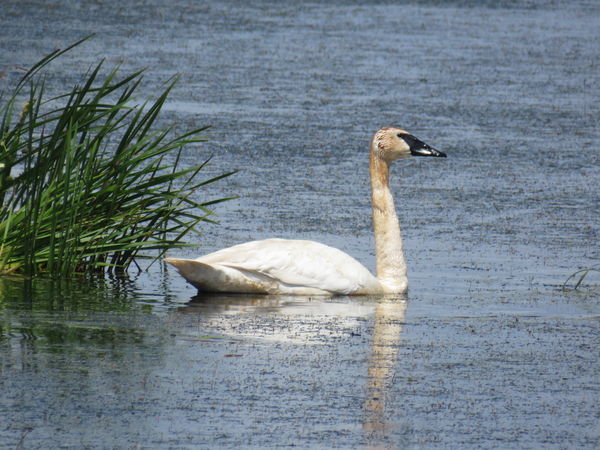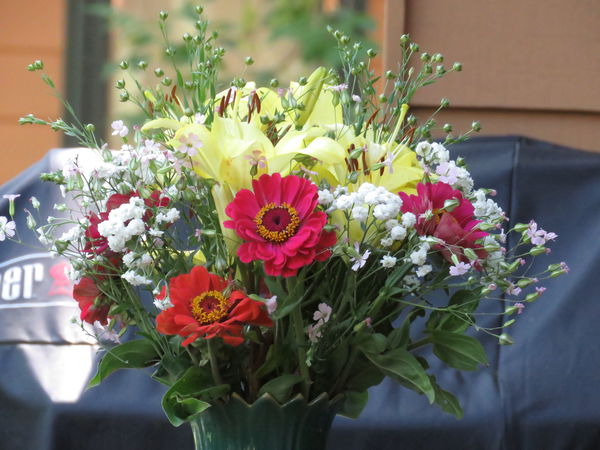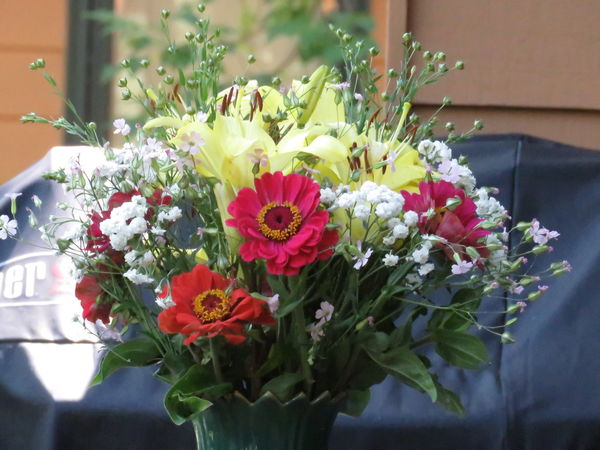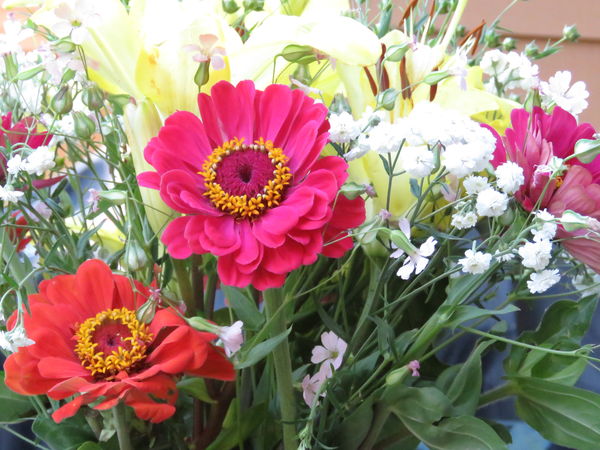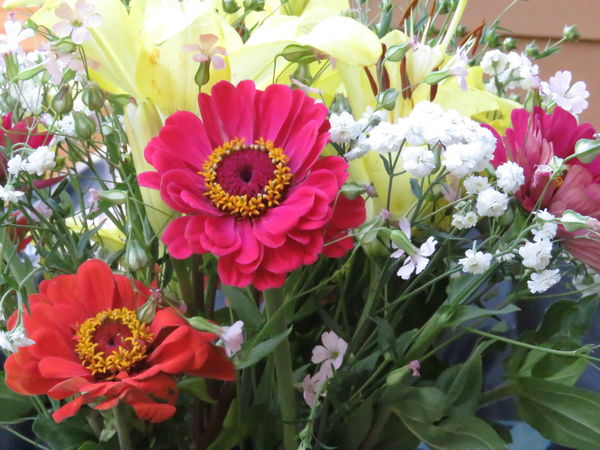Posts for: robinboulton
Jul 21, 2017 19:33:55 #
Thanks, all of you, for sharing your knowledge and wisdom (even if I didn't want to hear some of it!) :)
I take all the points about sensor size, camera shake, etc. I even knew in my deepest heart that these factors were all in play. I'm 65 and have shaky hands, and while I do use a tripod for landscapes, for instance, these birds were moving quite fast (windy day, as can be inferred by the ripples in the water) so to get the shots, at those distances, I had to be mobile (I was actually driving along a county road which runs alongside the marsh). I would try a shot or two, the birds would move out of range, I'd get in the car and drive half a mile to the next vantage point, try again... rinse and repeat.
The black specks are actually the tips of reeds/bulrushes/whatevers that are poking through the surface of the water.
Amfoto1, thanks to you in particular for the time and effort you put into your reply. The point about sensor sizes is telling. I may have to recompose myself (he he) as a landscape-only photographer, or be content with what I can do with my older Nikon D40. dpReview says that camera has a 23.7 x 15.5 mm sensor, which would yield about 367 mm square... can that be right? It seems large for a camera of that vintage. Oh but that limiting 300 mm zoom lens...
Yes, I acknowledge the limitations of my camera which, amplified by my own, are proving difficult to overcome. Yet, withal, it IS still an amazing piece of work, and unless someone has one of those $120,000 Canon lenses lying around that they are prepared to lend me, the SX 60 is what I have to work with. The comment about never submitting a photo from one to a stock company is sobering, as I had hopes of that avenue, but the sad truth is that it was the most camera I could afford at the time - and still is. Until I get those royalties rolling in upgrades are not us.
Thanks again to all of you - I really appreciate your time and interest.
I take all the points about sensor size, camera shake, etc. I even knew in my deepest heart that these factors were all in play. I'm 65 and have shaky hands, and while I do use a tripod for landscapes, for instance, these birds were moving quite fast (windy day, as can be inferred by the ripples in the water) so to get the shots, at those distances, I had to be mobile (I was actually driving along a county road which runs alongside the marsh). I would try a shot or two, the birds would move out of range, I'd get in the car and drive half a mile to the next vantage point, try again... rinse and repeat.
The black specks are actually the tips of reeds/bulrushes/whatevers that are poking through the surface of the water.
Amfoto1, thanks to you in particular for the time and effort you put into your reply. The point about sensor sizes is telling. I may have to recompose myself (he he) as a landscape-only photographer, or be content with what I can do with my older Nikon D40. dpReview says that camera has a 23.7 x 15.5 mm sensor, which would yield about 367 mm square... can that be right? It seems large for a camera of that vintage. Oh but that limiting 300 mm zoom lens...
Yes, I acknowledge the limitations of my camera which, amplified by my own, are proving difficult to overcome. Yet, withal, it IS still an amazing piece of work, and unless someone has one of those $120,000 Canon lenses lying around that they are prepared to lend me, the SX 60 is what I have to work with. The comment about never submitting a photo from one to a stock company is sobering, as I had hopes of that avenue, but the sad truth is that it was the most camera I could afford at the time - and still is. Until I get those royalties rolling in upgrades are not us.
Thanks again to all of you - I really appreciate your time and interest.
Jul 21, 2017 18:34:48 #
Jul 20, 2017 16:54:23 #
I almost hesitate to post for fear of inciting a flame war... but then fireworks can be fun, so here goes (hoping nobody gets too badly burned).
When I got my first digital I used ISO at 100 or 200... lesson learned from film, and I saw no reason to differ. As I've tried to master my current camera I've done a tremendous amount of reading and searching, and found huge amounts of (often contradictory) information. One post I read recently (WISH I could remember the site!) suggested that since digital cameras have improved so much lately there is no longer a need to constrain ISO so much... or maybe at all... and suggested setting ISO auto and let the camera go.
On a recent trip to a wildlife sanctuary I decided to try this theory, and took several shots of pelicans and swans that I thought were quite good, and I submitted one (pelican 1) to Shutterstock - where I have a couple of other photos accepted. It was rejected: "Focus -- The main subject of this image is not in focus". I tried to sharpen it using Corel AfterShot and resubmitted (pelican 2), getting rejected again: "Noise / Artifacts / Film Grain -- Image contains excessive noise, film grain, compression artifacts".
I wonder whether the free-range ISO I was using could be a causative factor in all this - why pelicans 1 and 2 didn't fly :)
I also attach for purposes of comparison a couple of other shots taken in the same few minute-span, using the same camera settings (swan 1 and swan 2) - these straight out of the camera with no PP.
I will read with great interest opinions on (1) using auto-ISO versus tightly constraining it, and (2) whether the high ISO caused the rejection of (pelican 2) following PP.
Thank you.
When I got my first digital I used ISO at 100 or 200... lesson learned from film, and I saw no reason to differ. As I've tried to master my current camera I've done a tremendous amount of reading and searching, and found huge amounts of (often contradictory) information. One post I read recently (WISH I could remember the site!) suggested that since digital cameras have improved so much lately there is no longer a need to constrain ISO so much... or maybe at all... and suggested setting ISO auto and let the camera go.
On a recent trip to a wildlife sanctuary I decided to try this theory, and took several shots of pelicans and swans that I thought were quite good, and I submitted one (pelican 1) to Shutterstock - where I have a couple of other photos accepted. It was rejected: "Focus -- The main subject of this image is not in focus". I tried to sharpen it using Corel AfterShot and resubmitted (pelican 2), getting rejected again: "Noise / Artifacts / Film Grain -- Image contains excessive noise, film grain, compression artifacts".
I wonder whether the free-range ISO I was using could be a causative factor in all this - why pelicans 1 and 2 didn't fly :)
I also attach for purposes of comparison a couple of other shots taken in the same few minute-span, using the same camera settings (swan 1 and swan 2) - these straight out of the camera with no PP.
I will read with great interest opinions on (1) using auto-ISO versus tightly constraining it, and (2) whether the high ISO caused the rejection of (pelican 2) following PP.
Thank you.
Jul 16, 2017 14:37:50 #
I totally agree it's a great camera, and most of my frustrations come from not knowing enough (yet). One issue I have is that I read widely on the many web sites, newsletters etc., which abound, but almost all the skills, techniques, tips and tricks refer to newer, more sophisticated gear... I'm just catching up with that concept and realizing I have to be content with what I have rather than trying to emulate the things that other cameras can do.
Thanks.
Thanks.
Jul 15, 2017 13:39:45 #
Thanks to everyone for advice and suggestions (except for the one to "read the manual" - have you ever TRIED to read the manual for that camera? A kitten with a ball of yarn is linear by comparison).
I apologize for not responding earlier - I had to have some dental unexpected dental surgery. My advice - if you're ever invited to a molar extraction party, don't go.
So, it seems there is general agreement that this lens has some issues with DoF that maybe a 200 or 300 mm lens might not. I decided to try the suggestion of getting further away, and made some test shots. They do not seem to help a lot. The first two were made at around 20 ft from the flowers, and the second two from around 4 ft; I used the file info as file names so you can tell what my settings were.
I find them all disappointing in terms of saturation, vividness, and sharpness. All were taken from my tripod.
I plan to try the same experiment with my older Nikon and its 18-70 mm lens and its 70-300 mm lens, when I get a chance, and I'll try to post those in case there's anyone who isn't comatose by then.
If anyone has further comments I would be happy to receive them (except for "read the manual") Thank you!
Thank you!
I apologize for not responding earlier - I had to have some dental unexpected dental surgery. My advice - if you're ever invited to a molar extraction party, don't go.
So, it seems there is general agreement that this lens has some issues with DoF that maybe a 200 or 300 mm lens might not. I decided to try the suggestion of getting further away, and made some test shots. They do not seem to help a lot. The first two were made at around 20 ft from the flowers, and the second two from around 4 ft; I used the file info as file names so you can tell what my settings were.
I find them all disappointing in terms of saturation, vividness, and sharpness. All were taken from my tripod.
I plan to try the same experiment with my older Nikon and its 18-70 mm lens and its 70-300 mm lens, when I get a chance, and I'll try to post those in case there's anyone who isn't comatose by then.
If anyone has further comments I would be happy to receive them (except for "read the manual")
 Thank you!
Thank you!Jul 8, 2017 12:54:09 #
Hi - It seems most (everyone?) on here is using more sophisticated equipment than I have and may not have any advice to offer but any that is offered will be gratefully received.
I have a Canon Powershot sx60 HS, the best I could afford when preparing for a long trip. I love the 1365 mm equivalent zoom, but I am having other problems that may be related.
(Before continuing I should add that I am basically a hopeful amateur; I have used another dSLR (Nikon D40) but hardly use it any more. I have read SO many articles about DoF, apertures, ISO, AEB HDR AWB etc. I feel I have a lot of knowledge - but the more I learn from reading, the more confused I seem to get when shooting and the worse, overall, my results seem to get). All the web sites refer to much more modern, more complex cameras than mine and I have concluded that much of the info available simply doesn't translate to mine.
So the specific issue(s) I am having: I choose my aperture setting according to the DoF I want, but I 'm not getting the right results: the focus seems off or the image is blurry. I think what I am trying to do is to constrain AF to work within the DoF I'm seeking (I don't know know if that makes sense but it's the only way I can think of to describe it). Does anyone know if there's a way to control AF +within+ the view I'm seeing through the viewfinder?
On a related note, I have been seeing/reading a lot about back button focus lately and I believe in it and want to try it, but... I can't figure out a way to make it work with my camera. Any ideas?
Thanks for taking time to read, and extra points to anyone who can offer suggestions that work!
I have a Canon Powershot sx60 HS, the best I could afford when preparing for a long trip. I love the 1365 mm equivalent zoom, but I am having other problems that may be related.
(Before continuing I should add that I am basically a hopeful amateur; I have used another dSLR (Nikon D40) but hardly use it any more. I have read SO many articles about DoF, apertures, ISO, AEB HDR AWB etc. I feel I have a lot of knowledge - but the more I learn from reading, the more confused I seem to get when shooting and the worse, overall, my results seem to get). All the web sites refer to much more modern, more complex cameras than mine and I have concluded that much of the info available simply doesn't translate to mine.
So the specific issue(s) I am having: I choose my aperture setting according to the DoF I want, but I 'm not getting the right results: the focus seems off or the image is blurry. I think what I am trying to do is to constrain AF to work within the DoF I'm seeking (I don't know know if that makes sense but it's the only way I can think of to describe it). Does anyone know if there's a way to control AF +within+ the view I'm seeing through the viewfinder?
On a related note, I have been seeing/reading a lot about back button focus lately and I believe in it and want to try it, but... I can't figure out a way to make it work with my camera. Any ideas?
Thanks for taking time to read, and extra points to anyone who can offer suggestions that work!
